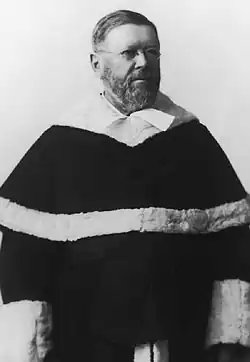John Idington
John Idington | |
|---|---|
 John Idington in 1914 | |
| Puisne Justice of the Supreme Court of Canada | |
| In office February 10, 1905 – March 31, 1927 | |
| Nominated by | Wilfrid Laurier |
| Preceded by | Albert Killam |
| Succeeded by | John Lamont |
| Personal details | |
| Born | October 14, 1840 Puslinch, Upper Canada |
| Died | February 7, 1928 (aged 87) Ottawa, Ontario |
| Resting place | Avondale Cemetery, Stratford |
| Spouse | Margaret Colcleugh |
| Children | 11 |
| Alma mater | University of Toronto |
| Profession | Lawyer |
John Idington (October 14, 1840 – February 7, 1928) was a Canadian justice of the Supreme Court of Canada.
Early life
Born in Puslinch, Upper Canada (now Ontario), the son of Peter Idington and Catherine Stewart, he received his LL.B degree from the University of Toronto and was called to the Ontario Bar, both in 1864. He practised law in Stratford, Canada West (now Ontario) for forty years.
Legal career
He was created a provincial QC in 1876 and a dominion QC in 1885.
A believer in the need for proportional representation, in 1898 he was chairman of the Proportional Representation Committee of Ontario.[1]
Idington had served as a Crown attorney and had experience in criminal and municipal law.[2]
In 1904, Prime Minister Wilfrid Laurier appointed Idington to the High Court of Justice of Ontario.[2]
Justice of the Supreme Court of Canada
On February 10, 1905, Prime Minister Wilfrid Laurier appointed Idington to the Supreme Court of Canada, to replace Justice Albert Clements Killam who resigned to become Chief Commissioner of the Board of Railway Commissioners.[3] Idington had only been on the Ontario bench for a year before his appointment to the Supreme Court.[2] His appointment, which replaced the Court's only western representative with another justice from Ontario, surprised the legal community and western Canada, and prompted speculation that it was difficult to persuade judges to accept an appointment to the Supreme Court.[2][4]
As a justice, Idington was critical of the appeal to the Judicial Committee of the Privy Council, noting that "A later generation may laugh [when struggling with its results] ... but, meantime, we must accept it with becoming respect as a proper interpretation of the B.N.A. Act." and "[the Supreme Court] might better be described as a legal sifting machine for sorting out claims on their road to the Judicial Committee of the Privy Council which is the only final court of appeal in our system."[5]
His notable decisions include his dissent in Quong Wing v The King,[ps 1] in which he disagreed with the effects of racist legislation, on the basis that the use of the term "Chinaman" could not have been meant to refer to naturalized Canadians of Chinese origin.
In 1924, following the death of Sir Louis Henry Davies, Idington was passed over for the position of Chief Justice of Canada, even though he was the senior Pusine Justice on the Court.
He retired on March 31, 1927, at age 86, after legislation was passed requiring a mandatory retirement age of 75.[6]
References
- ^ Proportional Representation Committee of Ontario (1898). Effective Voting - the Basis of Good Municipal Government. p. 30.
- ^ a b c d Snell & Vaughan 1985, p. 88.
- ^ Snell & Vaughan 1985, pp. 87–88.
- ^ Bushnell 1992, p. 181.
- ^ Bushnell 1992, p. 192.
- ^ An Act to amend the Supreme Court Act, S.C. 1927, c. 38, s. 2.
Primary sources
- ^ Quong Wing v The King, 1914 CanLII 608, (1914) 49 SCR 440, Supreme Court (Canada)
Further reading
- Bushnell, Ian (1992). Captive Court: A Study of the Supreme Court of Canada. McGill-Queen's University Press. ISBN 978-0-7735-0851-4.
- Snell, James G.; Vaughan, Frederick (1985). The Supreme Court of Canada: History of the Institution. Toronto: The Osgoode Society. ISBN 978-0-8020-3417-5.
External links
- Works by or about John Idington at the Internet Archive
- Supreme Court of Canada biography
- "John Idington". Dictionary of Canadian Biography (online ed.). University of Toronto Press. 1979–2016.